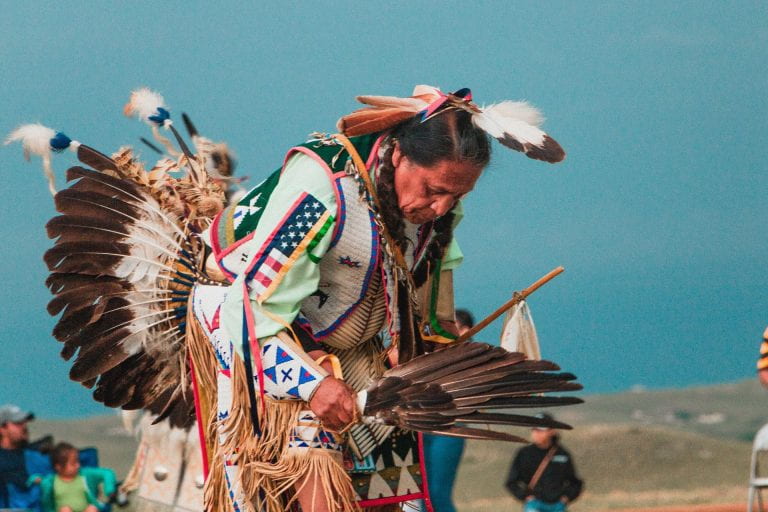From cultural and historical sites, to parks and preserves to pow wows and traditional festivals, North and South Dakota are rich in opportunities for visitors seeking to experience Native American places and ways of life.
While in general, a growing interest in authentic and cultural heritage travel is fueling an uptick in Indigenous tourism, many tribes and communities throughout the US are not yet convinced of tourism’s potential benefits, which go well beyond economic development.
As Seleni Matus, Executive Director of the George Washington University’s International Institute of Tourism Studies explains, “We know that tourism is often the most promising way for many Indigenous communities to generate income while giving these groups the financial capability to protect their lands and cultural traditions.”
Three years ago, the Masters of Tourism Administration students, under the auspices of the International Institute of Tourism Studies, helped to establish the North Dakota Native Tourism Alliance. The idea was to bring together the state’s five Indian Nations—the Sisseton Wahpeton, Standing Rock, Mandan-Hidatsa-Arikara, Turtle Mountain Band of Chippewa and Spirit Lake— to collaboratively design tourism opportunities and develop their own individual strategies around cultural heritage tourism.
While the project, developed with support from the Bureau of Indian Affairs Office of Indian Energy and Economic Development and Division of Transportation, is building the capacity for tourism and economic development generally, this year’s focus in particular has been on developing actual tourism products and experiences that will appeal to visitors from the US, Europe and Asia. For example, these include pow wows, visits with community elders and interpretive tours of historic and cultural sites.
In addition to working with community leaders to identify and develop products and experiences, the IITS team is helping tribes to establish pricing, market their products and train guides and interpreters. They’re also identifying tour operators and potential entrepreneurs interested in working with the tribes. And, also as part of the project, the GW teams helping to strengthen micro-enterprises, including those owned and operated by local artisans, storytellers and dancers.
“The International Institute of Tourism Studies (IITS) has been an instrumental partner, helping to inform and shape our program design and delivery,” explains Ed Hall, Tourism Coordinator at the U.S. Bureau of Indian Affairs. They designed the approach now used in our work in the Dakotas to create long-term investment in sustainable cultural tourism development for tribal communities. Our partnership provides graduate students with an opportunity to work in tribal communities and share their expertise while learning from the communities themselves. The project works with state representatives to identify existing resources, which can support tribal capacity building and facilitates coordination and access to these various resources, while identifying gaps or barriers that require additional support. Ultimately, however, it is the sovereign tribal nations and communities that must control their own tourism efforts and deliver products and experiences that are authentic to their own cultures and traditions.”
This year, the Institute expanded its reach to South Dakota, where it’s working with nine federally recognized tribes. Stakeholder meetings to establish the projects have been well received by the South Dakota Department of Tourism as well as officials including David Flute, Secretary of Tribal Affairs and Jim Hagan, Secretary of Tourism, both of whom attended recent gatherings. State representatives Senator Red Dawn Foster, Representative Shawn Bordeaux, and Representative Tamara St. John, all of whom are Native American, have also been attending meetings and publically endorsing our work.
In South Dakota, the initial goal is to develop a regional tourism strategy and build a regional alliance, similar to the approach taken in North Dakota. For now, the group is focused on addressing several challenges inherent to the state, including the concentration of tourism attractions in and around Rapid City and the Badlands National Park and the general lack of connectivity between these areas and the tribal nations.
Participants at recent meetings expressed their hope that tourism would be the vehicle to reestablish connections and reunite the Oceti Sakowin, the People of the Seven Council Fires. Until the arrival of trappers and settlers during the 1600s, these bands of the Sioux were united by language and kinship.
As meeting attendee Randy Ross, from the Alliance of Tribal Tourism Advocates said, "Tourism isn't just about money. It can make light and open a path to knowledge. Then, our future generations will have a place to hang their hat on. They will have a legacy. Tourism is a vehicle to humanity.”
Kansas Middletent from the Lower Brule Sioux Tribe added that, “This initiative is important in so many ways but overall, it allows us to control our narrative. We get to share our way of life through our own lens, our own perspective, that often isn’t told to in fullness or in truth.”
To explore the ways in which tourism can drive opportunity and contribute to a better quality of life for Indigenous communities, the Organization of American States and the George Washington University International Institute of Tourism Studies, in collaboration with the U.S. Bureau of Indian Affairs, are organizing a two-day Indigenous Tourism Forum of the Americas scheduled for March 17th to 18th, 2020 in Albuquerque, New Mexico. Visit the forum website to learn more and register.







